Serving Beverly Hills, Los Angeles, Santa Barbara and surrounding areas
Turbinates are structures on the sidewall of the inside of the nose. They project into the nasal passages as ridges of tissue. Their function is to clean and humidify the air as it moves through the nose into the lungs. Turbinate hypertrophy occurs when the turbinates are enlarged, which can lead to congested or blocked nasal breathing, breathing trouble at night and snoring, chronic nosebleeds, and/or chronic sinus infections. When medications do not remedy this condition, a turbinate reduction (turbinoplasty) may be required.
 Turbinate surgery corrects the problem of nasal obstruction by reducing the turbinate size and decreasing airway resistance while preserving the natural function of the turbinates. This improves nasal breathing and can also help to reduce nasal drainage and post-nasal drip. The surgery may be performed in conjunction with a surgical septoplasty, sinus surgery, or rhinoplasty.
Turbinate surgery corrects the problem of nasal obstruction by reducing the turbinate size and decreasing airway resistance while preserving the natural function of the turbinates. This improves nasal breathing and can also help to reduce nasal drainage and post-nasal drip. The surgery may be performed in conjunction with a surgical septoplasty, sinus surgery, or rhinoplasty.
Understanding the Procedure
Turbinate reduction does not involve cutting through the skin. It is performed entirely through the nostrils. Using an endoscope to improve visualization,Dr. Moradzadeh makes a small puncture in the mucosal lining of the turbinate and carefully reduces the size of the turbinate with amicrodebrider device. This innovative device allows the turbinate to be reduced on the inside without damaging the mucosal lining.
It is important that the turbinate not be removed completely because that can result in dry, crusty turbinate. Without a turbinate, the air an individual breathes does not get adequately humidified and warmed. Sometimes turbinate tissue will re-grow after turbinate surgery, in which case the procedure may need to be repeated.
What to Expect Afterwards
Patients can expect mild pain, nasal stuffiness, and mild nasal drainage after the procedure. These conditions, which are a normal part of the healing process, improve significantly after the first week. Dr. Moradzadeh may advise you to use saline sprays or irrigations after the surgery, and will give you other post-operate instructions to ensure that your nose heals properly.


